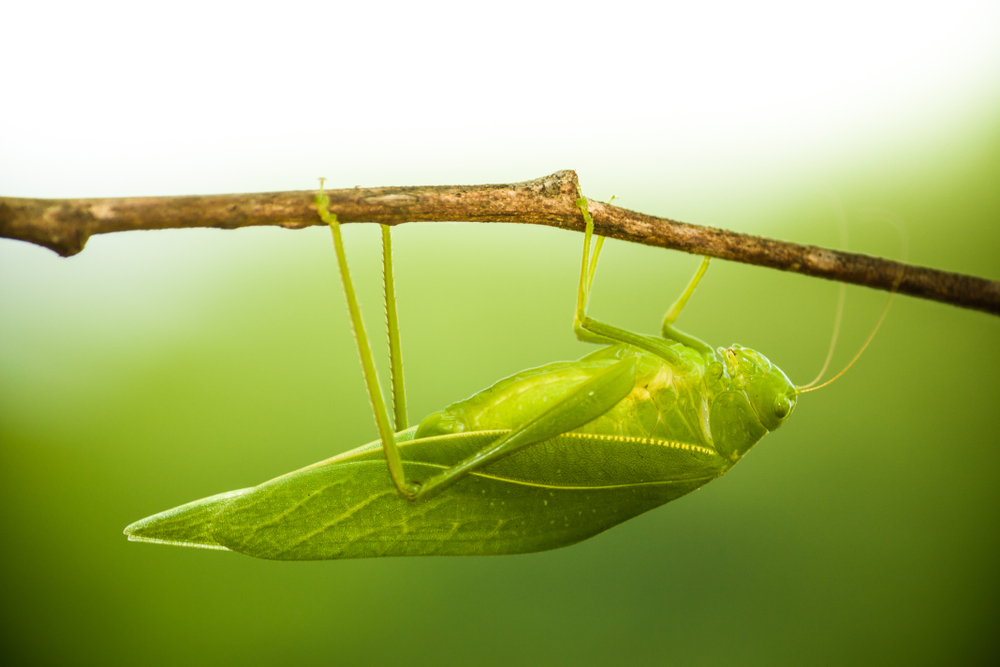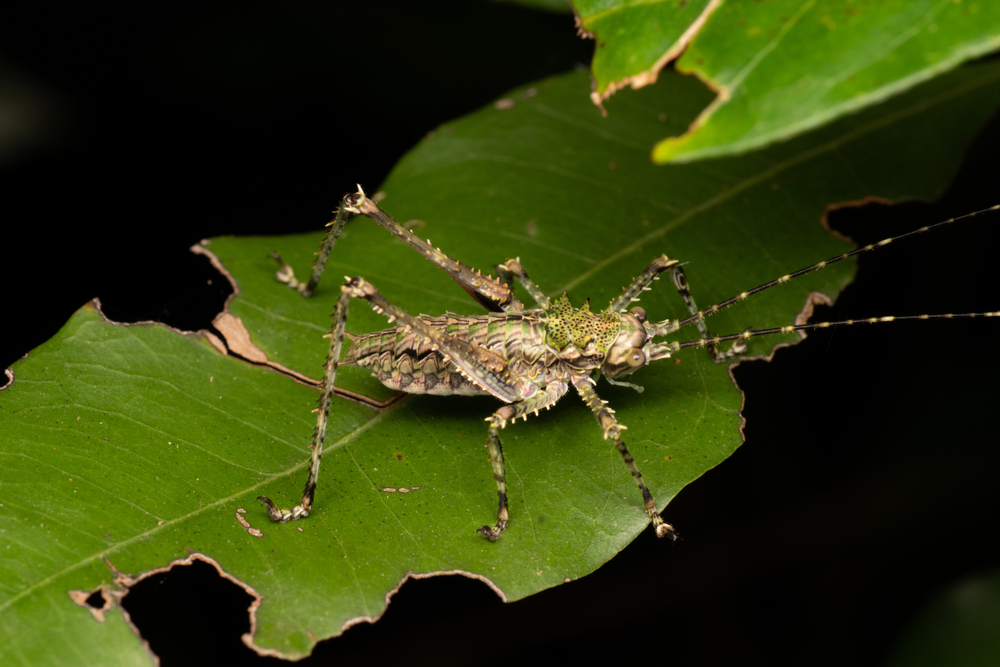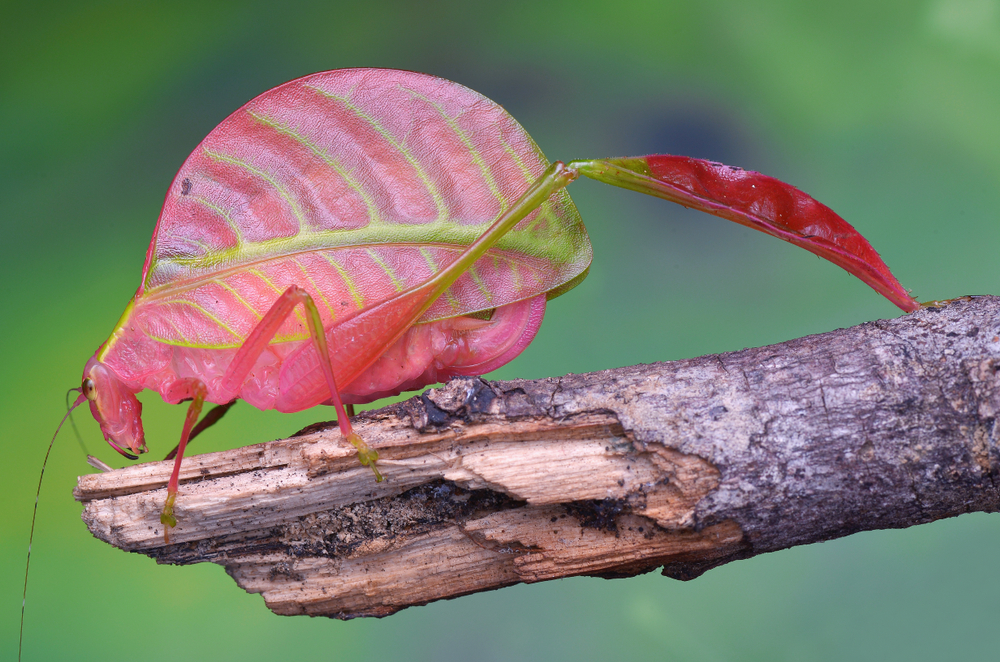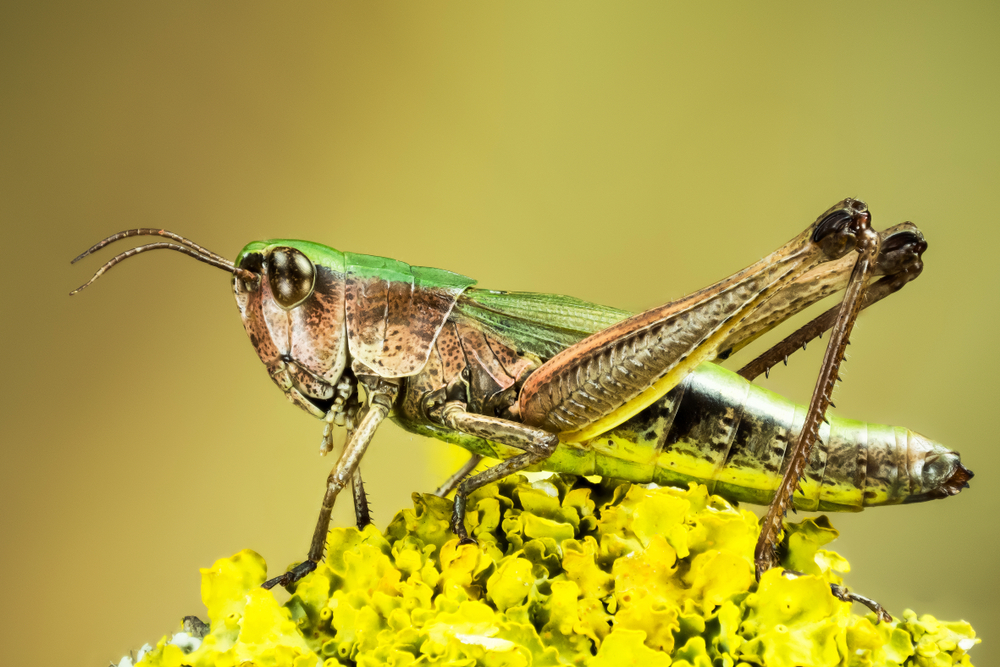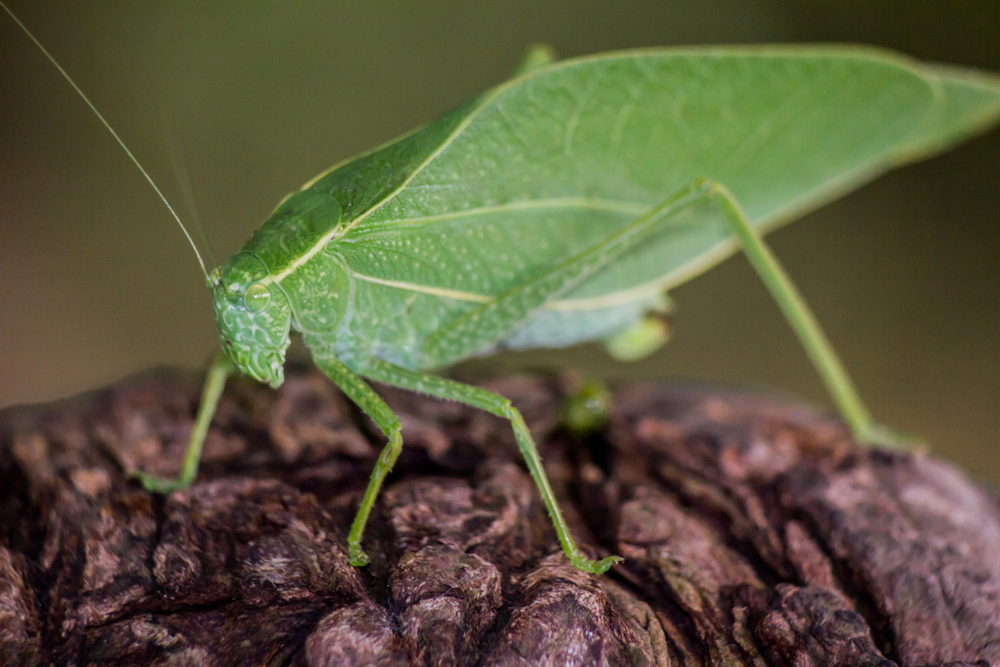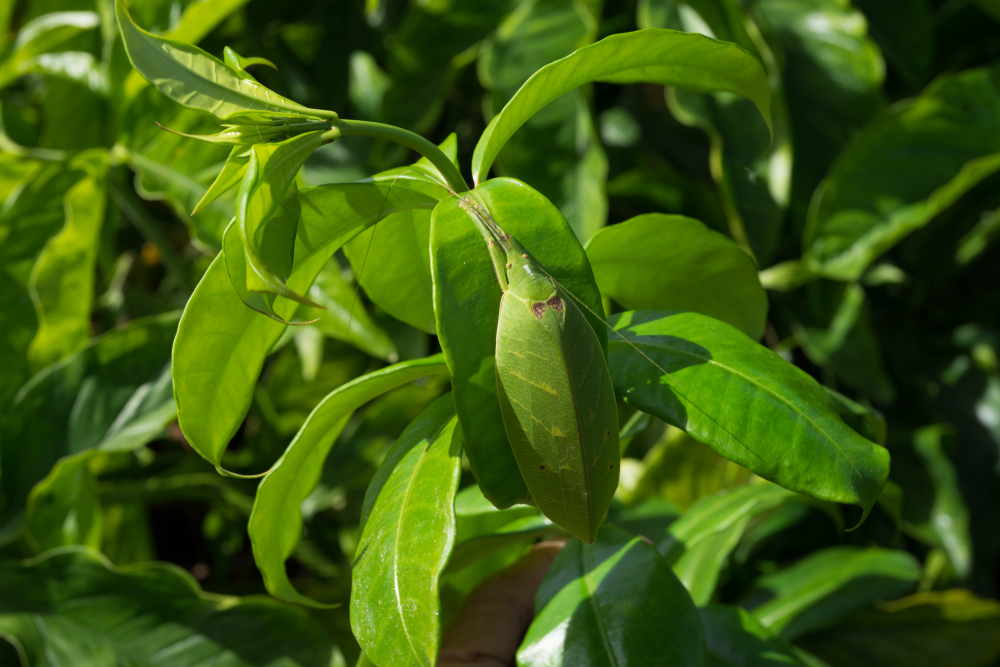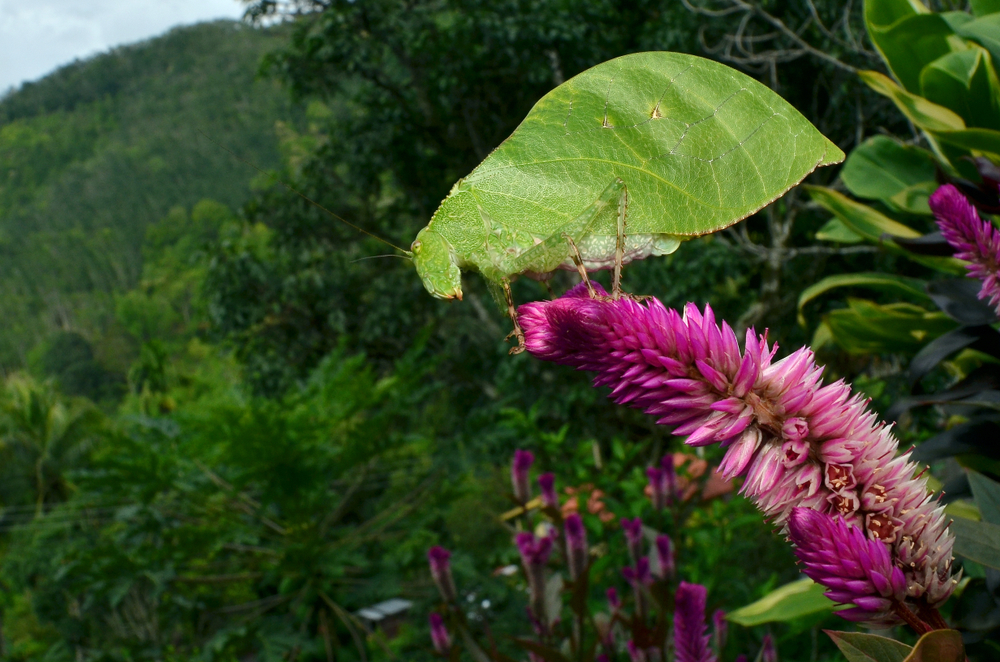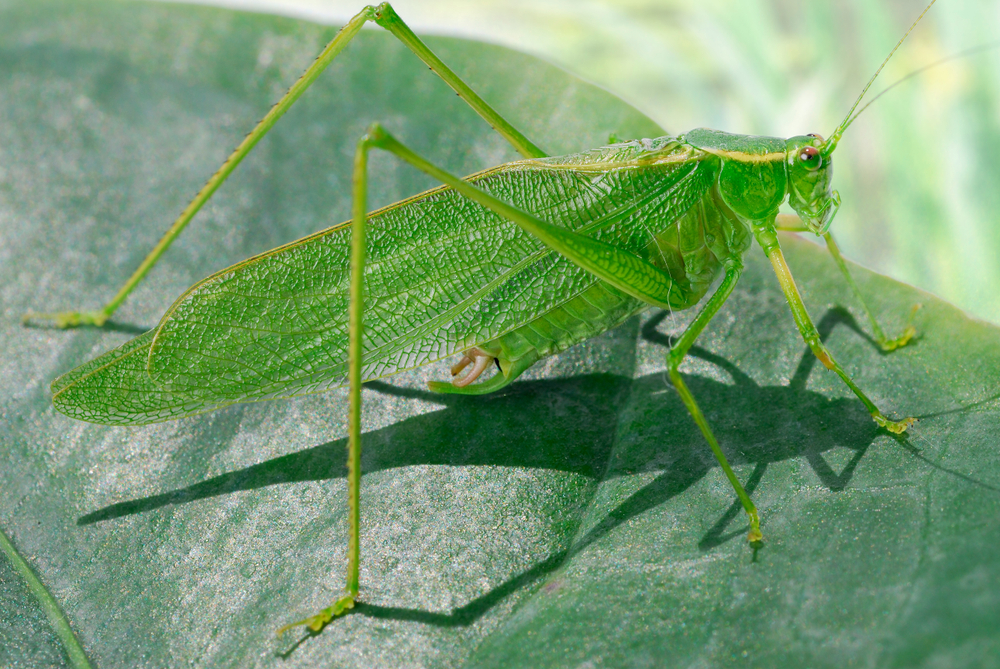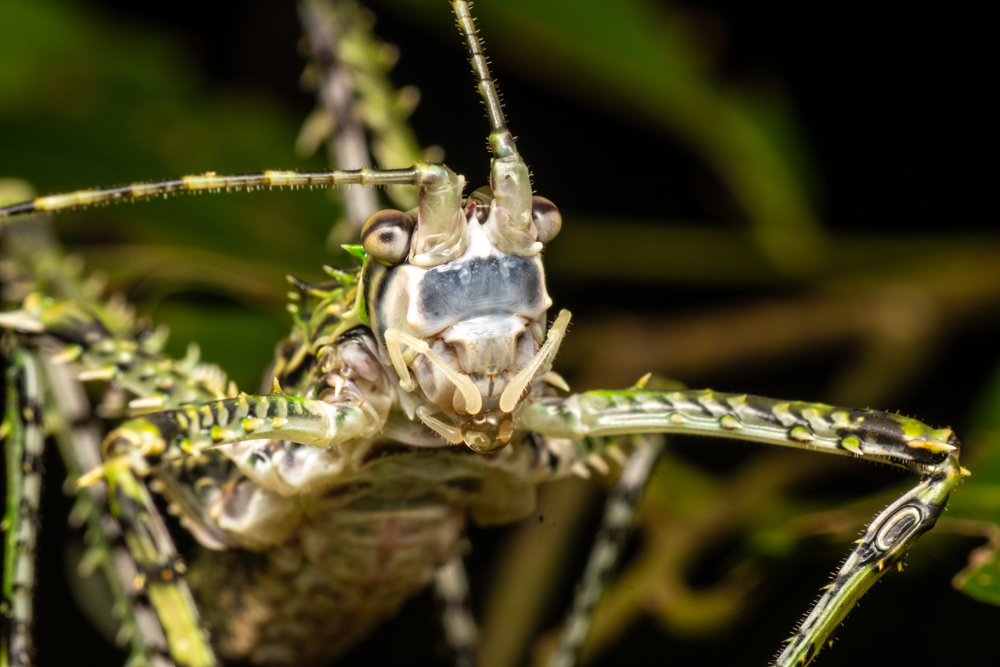The Katydidae family, commonly known as katydids or bush crickets, is a diverse group of insects with thousands of species worldwide. These species vary in size, coloration, and behavior. It is estimated that there are over 6,400 recognized species within the family Katydidae, and scientists continue to discover and classify new species. The exact number of katydid species may change as further research and taxonomic studies are conducted, but they are known for their remarkable diversity and adaptation to various habitats around the world.
About
Katydid, a member of the Tettigoniidae family, is a remarkable insect that belongs to the class Insecta within the Animal Kingdom. This fascinating group of insects is well-known for its distinctive songs, which are produced by males to attract females during mating rituals. Katydid species are distributed worldwide and are particularly diverse in tropical regions, where they inhabit various ecosystems.
Katydids exhibit a wide range of physical characteristics, but they are generally characterized by their long, slender bodies and prominent, elongated antennae. Their cryptic coloration often matches the vegetation in their habitats, making them masters of camouflage. This camouflage helps them evade predators and go unnoticed by potential prey.
One of the most intriguing features of katydids is their ability to produce sounds, primarily through stridulation. They possess specialized structures on their wings or legs that they rub together to create distinct calls. These calls play essential roles in communication, helping individuals locate mates and establish territories.
In addition to their acoustic talents, katydids are herbivorous insects, feeding primarily on plant matter such as leaves, flowers, and stems. Their diverse diet, coupled with their cryptic appearances and acoustic communication, makes them intriguing subjects for ecological studies and a vital part of various ecosystems.
Conservation Concerns
Katydid species are not individually assessed for conservation status on the IUCN Red List. However, like many other insect species, they may face threats from habitat loss, pesticide use, climate change, and other human-induced environmental changes. Habitat destruction and fragmentation due to agriculture, urbanization, and deforestation can negatively impact katydid populations by reducing available habitat and food resources.
Physical Characteristics
The physical appearance of a Katydid varies among species, but they share some common features:
Appearance:
- Body: Katydids have elongated, slender bodies with a generally cylindrical shape. Their bodies can range from green to brown, providing effective camouflage among vegetation.
- Antennae: They have long, thread-like antennae that can be longer than their bodies.
- Wings: Katydids typically have two pairs of wings, with the front pair, called tegmina, being leathery and the hind wings being membranous. These wings allow them to fly.
- Legs: They have six long, jointed legs equipped with sharp spines for grasping vegetation and climbing.
- Head: The head features large, compound eyes that provide good vision, helping them locate prey and mates.
Size:
- The size of a Katydid varies depending on the species and stage of development.
- Adult Katydid lengths can range from about 1 to 6 inches (2.5 to 15 centimeters).
Weight:
- Katydids are relatively lightweight insects.
- Their weight varies based on size, but they typically weigh between 0.04 ounces (1 gram) to 0.7 ounces (20 grams).
Katydids are well-adapted to their environments, with their slender bodies and cryptic coloration allowing them to blend into vegetation. Their long antennae help them detect environmental cues and communicate with other individuals. While they may appear delicate, Katydids are skilled climbers and flyers, making them effective herbivores and important members of various ecosystems.
Reproduction
Katydid’s reproductive cycle is fascinating and includes several key stages:
Courtship: The reproductive process begins with courtship rituals, which are primarily initiated by males to attract females. These rituals often involve acoustic signals, where males produce distinctive calls by rubbing their wings together. These calls serve to attract females and establish territory.
Mating: Once a female is attracted to a male’s courtship call, they engage in mating. Mating can be a complex process, with males often transferring a spermatophore containing sperm to the female’s reproductive tract. Some species may also engage in copulatory courtship, where the male deposits sperm directly.
Egg-Laying: After mating, the female typically searches for suitable locations to lay her eggs. She often inserts eggs individually into plant tissues or other substrates, sometimes using her specialized ovipositor to place them securely. The choice of egg-laying sites can vary depending on the species.
Gestation Period: The gestation period for katydids varies depending on environmental conditions and species. It typically lasts several weeks to a few months. During this time, the eggs develop within the protective egg case or ootheca.
Hatching: Once the eggs have fully developed, young katydids, known as nymphs, hatch from the eggs. Nymphs resemble miniature versions of adult katydids but lack fully developed wings.
Young Katydids: The nymphs emerge from their eggs and begin their life cycle. They undergo a series of molts as they grow, shedding their exoskeletons to accommodate their increasing size. Each molt is followed by a period of immobility and vulnerability until the new exoskeleton hardens.
The number of young katydids hatched from a single clutch of eggs varies depending on the species and environmental factors. It can range from a few to several dozen individuals. Katydids are well-known for their acoustic behaviors during courtship and mating, which play a crucial role in attracting mates and ensuring successful reproduction.
Lifespan
The lifespan of a Katydid can vary depending on factors such as species, environmental conditions, and the presence of predators. Here’s an overview of their lifespan:
In the Wild:
- In the wild, Katydids typically have relatively short lifespans, with most individuals surviving for a few months to a year.
- The duration of their lives can vary among species, with some living longer than others.
- The nymphal stage, during which they undergo multiple molts and develop into adults, usually lasts several weeks to a few months.
- Adult Katydids may live for several weeks to a few months, during which they engage in courtship, mating, and egg-laying activities.
- Katydids are susceptible to predation by birds, spiders, and other insects, which can significantly impact their survival.
In Captivity:
- In captivity, Katydids may live slightly longer than their wild counterparts, primarily due to the absence of predation and favorable environmental conditions.
- Captive Katydids can live anywhere from a few months to around a year or more, depending on care and conditions.
Biggest Threats:
- Predation: In the wild, predation is a significant threat to Katydids. They are preyed upon by birds, spiders, mantises, and other insects.
- Habitat Loss: Habitat destruction and fragmentation due to human activities, such as deforestation and urbanization, can reduce the availability of suitable habitats for Katydids.
- Pesticides: Katydids, like other insects, can be affected by the use of pesticides in agriculture and gardens, leading to population declines.
- Climate Change: Climate change can disrupt ecosystems and affect the availability of food and suitable habitats for Katydids.
While Katydids have relatively short lifespans, they play essential roles in ecosystems as herbivores and contribute to nutrient cycling. Conservation efforts aimed at preserving their habitats and reducing the use of harmful pesticides can help mitigate some of the threats to their populations.
Eating Habits
Katydids are primarily herbivorous insects with specialized feeding habits. Here’s a description of their eating habits:
Diet:
- Katydids are known for their preference for plant matter. They primarily feed on a variety of plant parts, including leaves, stems, flowers, and occasionally fruits.
- Some species are highly specialized and may have specific plant preferences, while others are more generalist feeders, consuming a wide range of plant species.
Feeding Mechanism:
- Katydids have specialized mouthparts designed for chewing and grinding plant material. Their mandibles are adapted for efficiently breaking down plant cell walls.
- They use their sharp mandibles to bite and chew through leaves, stems, or other plant parts, consuming the soft plant tissues while discarding tougher, fibrous portions.
Feeding Behavior:
- Katydids are typically nocturnal feeders, coming out at night to forage for food. Their cryptic coloration and slow, deliberate movements help them go unnoticed by predators while they feed.
- They are known for their voracious appetites, and their feeding can have a noticeable impact on vegetation in their habitats.
- Katydids are often found on a variety of plants, including trees, shrubs, and grasses, depending on their species and local availability of food sources.
Gathering Food:
- Katydids use their strong and agile legs to grasp and hold onto plant material while they feed. Their spiny legs provide a firm grip on leaves and stems.
- They are typically solitary feeders, although they may occasionally encounter other katydids while foraging.
Katydids play important roles in ecosystems as herbivores, contributing to the cycling of nutrients within plant communities. While they primarily feed on plant matter, their feeding behaviors can vary among species, and some may consume specific plants or exhibit preferences for certain plant parts.
Uniqueness
Katydids are unique insects with several distinctive features and behaviors that set them apart from other insects:
- Acoustic Abilities: Katydids are renowned for their acoustic talents. Males produce intricate songs by rubbing their wings together, a behavior known as stridulation. These songs serve various purposes, including attracting females for mating and establishing territory. Each species has its distinct song, making them easily distinguishable by their calls.
- Camouflage Masters: Many Katydids are exceptional masters of camouflage. Their body shapes and cryptic coloration often match the vegetation in their habitats. This camouflage helps them evade predators while they forage for food or search for mates.
- Herbivorous Diet: Katydids are primarily herbivorous, feeding on a variety of plant materials. They use specialized mouthparts to efficiently chew and consume plant tissues. Their voracious appetites can have noticeable effects on vegetation.
- Cryptic Behavior: Katydids are primarily nocturnal and exhibit slow, deliberate movements. Their cryptic behavior, combined with their nocturnal lifestyle and camouflage, helps them avoid predators while they go about their activities.
- Courtship and Mating Rituals: The courtship and mating rituals of Katydids are fascinating and diverse. Males often use their acoustic abilities to attract females, and some species engage in elaborate courtship displays. Sexual cannibalism, where the female consumes the male during or after mating, is observed in some species and serves various evolutionary purposes.
- Egg-Laying and Oothecae: Female Katydids lay their eggs in various locations, often using specialized ovipositors to insert them securely into plant tissues or other substrates. The eggs are typically encased in protective foam-like structures called oothecae, which safeguard the developing eggs from environmental threats.
- Ecosystem Role: Katydids play vital roles in ecosystems as herbivores. Their feeding activities contribute to nutrient cycling and can influence plant communities within their habitats.
- Variety of Species: The Katydidae family is incredibly diverse, with thousands of species worldwide. This diversity includes variations in size, coloration, and behavior, making each species unique in its own right.
- Regeneration Abilities: Katydids can regenerate lost limbs during molting. This remarkable ability allows them to recover from injuries and continue their life cycles.
These unique characteristics and behaviors make Katydids intriguing subjects for ecological research and observations in the natural world. Their songs, camouflage, and diverse adaptations contribute to their success as insects in a wide range of ecosystems.
FAQ’s
1. How many types of Katydids are there?
2. What are some of the more popular species of Katydids?
There are numerous katydid species, and popularity can vary depending on region and habitat. Here are descriptions of 10 relatively common katydid species:
- Common True Katydid (Pterophylla camellifolia): Recognizable by its bright green color and large size, it produces a loud “katy-did” call in summer.
- Northern True Katydid (Pterophylla camellifolia): Similar to the common true katydid but found in the northern United States.
- Angular-Winged Katydid (Microcentrum rhombifolium): Named for its angular wings, it produces a distinctive “katy-did, katy-didn’t” song.
- Treetop Bush Katydid (Scudderia fasciata): Camouflaged in brown and green, it mimics tree bark and leaves, making it challenging to spot.
- Differential Grasshopper (Melanoplus differentialis): Often mistaken for katydids, they are grasshoppers known for their color variation.
- Meadow Katydid (Orchelimum concinnum): Found in grassy habitats, males produce a high-pitched trill during the night.
- Black-legged Meadow Katydid (Orchelimum nigripes): Named for its black legs, it’s a common grassland species.
- Lesser Angle-Winged Katydid (Microcentrum retinerve): Smaller and less angular than some relatives, it emits a soft, high-pitched trill.
- Common Conehead (Neoconocephalus nebrascensis): Distinguished by its cone-shaped head and robust body, it’s known for its buzzing calls in tall grasses.
- Straight-Lanced Meadow Katydid (Conocephalus strictus): Found in marshes and grasslands, it sings a soft trill at night and has distinctive body markings.
These katydids are just a small sample of the diverse katydid species found worldwide, each with its unique characteristics and behaviors
Related Family Species
Sources
- Britannica, Katydid, https://www.britannica.com/animal/long-horned-grasshopper, retrieved January 2024.
- Burnie, David & Wilson, Don, Animal, Smithsonian Institute, Washington DC.
- Hickman et al, Integrated Principle of Zoology, McGraw Hill, Boston.



































































